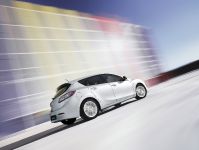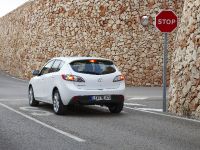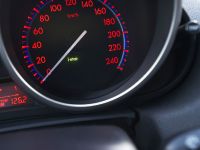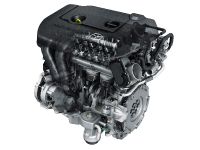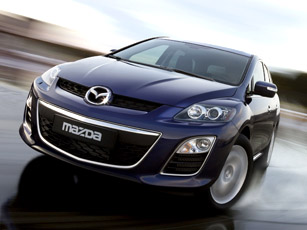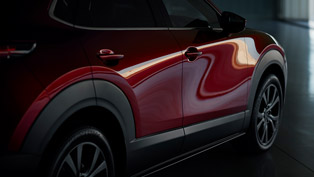Mazda3 + i-stop Green Technology for the new Mazda3
The Mazda stand at this year's Geneva Motor Show is greener than ever before. One way Mazda achieved this is to develop unique idle-stop technology that shuts down the engine when stopped in traffic jams and similar situations as a way to reduce fuel consumption.
The Mazda3 will be powered by the MZR 2.0L DISI engine with green idle-stop technology – Mazda's unique i-stop system. Developed solely by Mazda, it is the world's only idle-stop system that restarts the engine using the remaining energy in the pistons (with a quick help of the starter motor) by injecting fuel directly into the cylinder and igniting it to force the piston down. The benefit of combining a DISI engine with i-stop (originally called SISS: Smart Idle Stop System) is that the system restarts the engine about twice as fast, and quieter, than conventional idle-stop systems.
Combining these two Mazda proprietary technologies and further measures like aerodynamic modifications, help the new Mazda3 achieve approximately 14 percent lower fuel consumption (combined) than the previous Mazda3.
When the driver stops the vehicle (red light, traffic jam) the engine stops automatically and sets itself to be ready for a prompt restart. As soon as the driver presses the clutch, the engine initiates the restart procedure automatically. This is a totally neutral operation for the driver.
Mazda3 Green i-stop Technology
How i-stop works – direct-Injection is the key When stopped at a traffic light or in a traffic jam, shutting off the idling engine can reduce fuel consumption by approximately 5 percent according to European city driving-mode tests. However, the drawback with conventional idle-stop systems is that they rely solely on the use of an electric motor to restart the engine. As such, they require a relatively long amount of time to achieve combustion in the engine when it restarts. In real-world driving, this means a lag between the moment the accelerator pedal is pressed down and the car begins to move, as well as vibration and noise.
The i-stop system for the new Mazda3 leverages the DISI engine's direct-injection potential for improving fuel economy, restarting the engine quickly and quietly by injecting fuel directly into the cylinder and igniting it to force the piston down and set the crank in motion. The engine is controlled with precision to make this happen:
Special engine requirements In order to use combustion energy from the initial stage of restarting the engine, and to start the engine quickly, the following three conditions must be satisfied while the engine is stopped. (1) The engine must be able to inject fuel directly into the combustion chamber and ignite it; (2) an adequate amount of clean air must exist in the combustion chamber of the cylinder where the fuel is to be ignited; and (3) the computer control system must be able to determine which cylinder to fire immediately after starting the engine. The i-stop system, therefore, must use a direct-injection engine that can deliver fuel to the combustion chamber at high pressure, and that can easily ignite that fuel. Mazda's MZR 2.0-litre DISI petrol is the ideal engine to achieve this.
Controlling piston position The pistons are stopped in the appropriate position when the engine is stopped, an adequate amount of air is held within the combustion chamber, and the combustion chamber is properly scavenged to reduce the amount of unburned petrol. To this end, piston position is controlled by applying current to the engine's generator while the engine is being shut down. In doing so, it operates much like an electric motor, while using the signal from the crank angle sensor that monitors piston position as control feedback to stop the piston in the appointed position within its expansion stroke.
Special valve and crankshaft balance control To scavenge the combustion chamber, the new Mazda3 i-stop system momentarily opens the throttle valve slightly during the shut down process. (The throttle valve is normally closed when shutting off the engine.) Regular crank angle sensors are only able to determine forward rotation, which leaves them unable to monitor reverse rotation or to determine the correct piston position. Mazda's i-stop employs a crank angle sensor that is able to monitor crank rotation in both directions, enabling it to accurately determine the correct piston position. To maintain the proper crankshaft balance when the engine is stopped, it is rotated slightly in the reverse direction.
Faster restart + lower fuel consumption These measures make it possible to properly inject fuel when the engine is restarted and control ignition advance, thereby allowing combustion energy to be used while the engine is stopped and to restart the engine in 0.35 seconds, roughly half the time required by conventional idle-stop systems. While Mazda's new i-stop system employs combustion energy to restart the engine, it is assisted by the starter for only the first few turns of the crank. This achieves the optimum balance between maximizing fuel savings while minimizing the amount of time required to restart the engine. As a result, it allows i-stop to reduce fuel consumption beyond what would be possible using combustion energy alone to restart the engine.
Driver support communication system On the new Mazda3 powered by the MZR 2.0 DISI engine, the i-stop system supports the driver by allowing visual confirmation of engine operation in relation to driving style. There is an i-stop on/off switch on the dashboard, and the driver cluster contains a light that displays "i-stop" when the system shuts down the engine in front traffic lights, for instance. When deactivated, an amber light shows that the i-stop system is not on.
Ensuring reliable operation The new Mazda3's i-stop system (only available with the MZR 2.0-litre DISI petrol) is equipped with an auxiliary battery that powers the system in the event that the main battery isn't properly charged or some similar problem occurs. This added control measure ensures that the driver can use the system naturally, without giving it a second thought. In addition, the system does not shut off the engine if the car is stopped on a road with an extremely steep grade, (greater than 14 percent incline).
New Mazda3 MZR 2.0 DISI + i-stop dimensions and specifications (subject to homologation)
| Model name |
|
Mazda3 MZR 2.0L DISI |
|
| Body type |
|
4-door sedan |
5-door hatchback |
| Dimensions |
|
|
|
| Overall length |
mm |
4,580 |
NAP: 4,460 SAP: 4,490 |
| Overall height |
mm |
1,470 |
1,470 |
| Overall width |
mm |
1,755 |
1,755 |
| Wheelbase |
mm |
2,640 |
2,640 |
| Gross vehicle weight |
kg |
1,255 |
1,270 |
| Luggage capacity |
l |
430 |
340 L (300 with Bose® system) |
| Drivetrain |
|
FWD |
FWD |
| Engine |
|
MZR 2.0L DISI |
MZR 2.0L DISI |
| Displacement |
cm³ |
1,999 |
1,999 |
| Bore x stroke |
mm |
87.5 x 83.1 |
87.5 x 83.1 |
| Compression ratio |
|
11.2 |
11.2 |
| Fuel tank capacity |
l |
55 |
55 |
| Batteries |
|
46B24L-S + 26B17L |
46B24L-S + 26B17L |
| Max. output |
kW/PS |
111/151 at 6,200 rpm |
111 /151 at 6,200 rpm |
| Max. torque |
Nm |
191 at 4,500rpm |
191 at 4,500rpm |
| Fuel consumption |
|
|
|
| Combined |
l/100km |
6.8 |
6.8 |
| Extra Urban |
l/100km |
5.4 |
5.4 |
| Urban |
l/100km |
9.3 |
9.3 |
| Emissions ranking |
|
Stage V |
Stage V |
| Exhaust system |
|
Single-nanotechnology |
Single-nanotechnology |
| Transmission |
|
6-speed manual transmission |
6-speed manual transmission |
| Max. speed |
km/h |
212 |
206 |
| Steering |
|
Electro-hydraulic power assisted system |
Electro-hydraulic power assisted system |
| Turns lock-to-lock |
|
2.94 |
2.94 |
| Min. turning circle |
m |
10.4 |
10.4 |
| Wall-to-wall diameter |
m |
10.9 |
10.9 |
| Suspension, front |
|
MacPherson struts |
MacPherson struts |
| Suspension, rear |
|
Multi-link |
Multi-link |
| Front brake type, diameter |
mm |
Ventilated discs, 300 |
Ventilated discs, 300 |
| Rear brake type, diameter |
mm |
Solid discs, 280 |
Solid discs, 280 |
| Coefficient of drag |
Cd |
0.28 |
0.30 |
| FA |
m² |
2.217 |
2.217 |
| Tyres, wheels |
|
205/55R16 16x6.5J |
205/55R16 16x6.5J |
|
|
205/50R17 17x7.0J |
205/50R17 17x7.0J |
|

